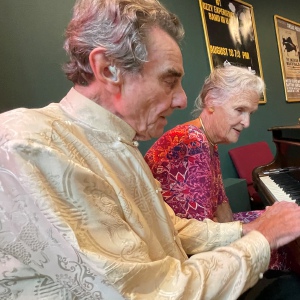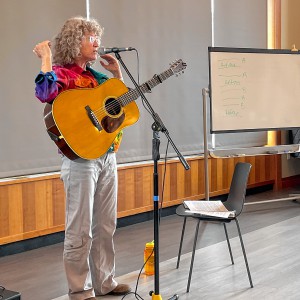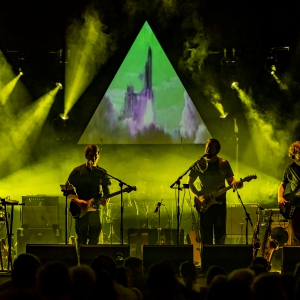Harris Center shares terrifying tales from the natural world
| Published: 10-31-2022 3:12 PM |
Halloween is a time of year when the spectacle of death, ghosts, and all things otherworldly, are celebrated with costumes, parties and trick-or-treating in the United States. But Halloween has nothing on the bizarre displays of terror that take place in the natural world.
Harris Center naturalists brought some of these displays to life for guests Oct. 26 at the Post and Beam Brewery in Peterborough by sharing true tales of cannibalism, zombification, kleptomania, envenomation, and other “dark doings” of wildlife.
Naturalists Jenna Spear and Susie Spikol and Science Director at the Harris Center Brett Amy Thelen spoke to a packed house and then fielded questions. The event, “Tiny Terrors,” was part of the Harris Center’s “Nature on Tap” series which features different science-based subjects around the holidays throughout the year.
One of the creatures addressed by the naturalists that raised a few hairs on people’s backs was the zombie parasite.
“Let’s see what the cauldron has in store for us,” Spikol said to the audience, reaching into a gray box full of questions. “Dear Doctor Frankenstein: I am a worker honey bee and lately some of my sisters have been acting really strangely leaving the hive at night, never to return. I saw one of them a week or so after she left and it looked like she had tiny maggots coming out of her head. What’s going on? Signed, Buzzing with Worry,” Spikol read to the crowd.
Spear, an entomologist, fielded the question explaining that this is a zombie parasite and that it is smaller than a fruit fly. The fly grabs onto a honey bee or a bumble bee, laying its eggs between the body segments, and injecting up to 24 eggs, she informed the crowd.
“The brain chemicals are changed in the bee, telling it to leave the hive at night which is completely against what any bee would do,” Spear said. “This is why her sister is so worried. Because they’re possessed by this parasite.”
Spear explained the bees are looking for artificial sources of light when in this “zombielike” state and they are often found under street lights or porch lights.
Article continues after...
Yesterday's Most Read Articles
“One person found them and noticed maggots coming out of the bees’ heads,” she said, adding that people can go online to participate in a zombie watch to see where these bees have been found.
Another question included the case of the werewolf mouse in the Sonoran desert of Arizona.
“Dear Doctor Frankenstein,” Spikol read, “I recently took a trip to Arizona where I went on a moonlit hike. I was walking slowly trying not to step on any scorpions when I heard a high-pitched howl in the distance. Looking up I could have sworn I saw a mouse howling at the moon like a werewolf. Am I losing my mind? Sincerely, Distressed in the Desert.”
Thelen fielded the question, informing the crowd that the creature being described is a grasshopper mouse, also known as the “werewolf mouse” because of its habit of howling at night.
“This is one of my favorite desert creatures,” Thelen said, noting that the grasshopper mouse is the only fully carnivorous mouse in North America, eating centipedes and other mice as well as Arizona bark scorpions which are among the most poisonous in the world. The grasshopper mouse, she continued, has a mutation in their pain pathway that turns the venom essentially into a pain pill that makes them immune to the scorpion venom.
“They can get stung in the face multiple times and not be affected,” she said, adding that the mice also bite the tails off of the scorpions to neutralize them as part of their hunting. There is a beetle, she said, that the mice bury in the sand rear end down before bite their heads off.
“And yes, they do howl in the night to mark their territory and to communicate with other grasshopper mice while standing on two legs. Truly a tiny terror, especially if you’re a scorpion.”
Spikol said the Nature on Tap series has been successful and that the center always tries to do events that are seasonally oriented.
“We wanted to offer people a chance to raise a glass and celebrate the wild things in nature in an easy-going happy hour talk,” Spikol said, adding that the events are “a bit of an antidote to the incredible amount of sad and distressing news we hear about the environment.”
“I love doing a Nature on Tap talk [because] it gives me a chance to take a deep dive into a wild topic, such as Tiny Terrors of the Natural World.”
Spikol will be giving a talk at NOVA Arts in Keene on Dec 15 from 7:30 to 8:30 p.m. which is a look at the role of the fly agaric mushroom in the mythology of Santa Claus.
“I am a proud nature geek and love learning new things about the natural world and then sharing them,” she said.

 Bernie Watson of Bernie & Louise dies at 80
Bernie Watson of Bernie & Louise dies at 80 Cosy Sheridan speaks and performs for Monadnock Writers’ Group
Cosy Sheridan speaks and performs for Monadnock Writers’ Group ‘The Last Laugh’ coming to Town Hall Theatre in Wilton
‘The Last Laugh’ coming to Town Hall Theatre in Wilton Echoes of Floyd performs Saturday at Peterborough Town House
Echoes of Floyd performs Saturday at Peterborough Town House
